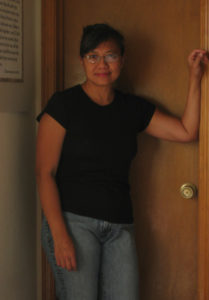Poet-a-Day: Meet Monica Sharman
I first met Monica Sharman when we worked together on Every Day Poems a few years back. We soon discovered that we not only have a love of poetry in common, but a Southern California upbringing (even though we’ve both since left the Golden State) and a knack for sawing away at the violin. So I was excited to find she has written some marvelous acrostic poems. I’m proud to include “What it Feels Like” in How to Write a Form Poem. Here’s a sneak peak of the first few lines. Not sure how it’s working as an acrostic? You’ll find out when you read the book—then be inspired to write your own!
What it Feels Like
Part of it simmers barely beneath
superficial, like a sunburn
just under the skin—
A spiritual neuralgia
traveling with time …
—Monica Sharman
Here’s what the poet herself has to say about her experience with the poem.
Tania Runyan (TR): Tell me a little about the origin story of “What it Feels Like”.
Monica Sharman (MS): I wrote it in response to a themed prompt on T.S. Poetry’s Facebook page. The theme for February 2012 was Red, and that color first made me think of this nerve pain that I’ve had since I was a child. I started by simply describing things that are true of my neuralgia experiences and eventually found that some characteristics of neuralgia are also true of non-physical pain.
TR: Why did you choose to write the poem as an acrostic?
MS: I chose the acrostic because it’s indirect, subtle, and sometimes undetected. Dealing with emotional pain directly would be too—well, too painful! But with an acrostic, a poem about pain doesn’t have to contain the word pain at all. (Whew!) Even in the title, I could only say “What It Feels Like” instead of “What Pain Feels Like.” Because any acrostic (if we’re not told it’s an acrostic) is hard to decipher, I felt somehow safer writing about a difficult topic, knowing that only the sensitive reader who’s really paying attention (a sign of genuine concern) would find the hidden word.
TR: What do you hope poets can learn from a book like How to Write a Form Poem?
MS: I hope it gives everyone the freedom and the fun of trying out form poetry! The given limits of form poetry act as a kind of happy fire under my feet, as if putting up gates and walls and structures around a poem (the form) actually fling open gates and blow out walls that hold back my bravery and even ability to write poems.
About Monica Sharman
Monica Sharman is a freelance editor, self-taught musician, and chocolatier. She thrives on the physical and mental challenges of athletics, especially martial arts. She and her husband have three sons and live in Colorado.
Hear Monica Read “What It Feels Like”
Photo by herdiephoto, Creative Commons, via Flickr. Post by Tania Runyan.
Browse more Poet-a-Day
Browse 50 States of Generosity
Check out The Yellow Wall-paper Graphic Novel
BUY ‘HOW TO WRITE A FORM POEM’ NOW!
- Flowers of California: California Poppy - December 8, 2022
- Flowers of California: Lily of the Nile - October 13, 2022
- Flowers of California: Crape Myrtle - October 5, 2022



Bethany R. says
Wonderful post. I’m particularly struck by this— “Because any acrostic (if we’re not told it’s an acrostic) is hard to decipher, I felt somehow safer writing about a difficult topic, knowing that only the sensitive reader who’s really paying attention (a sign of genuine concern) would find the hidden word.” The form allowed you to wade in at your comfort level. Love it. Thank you for sharing this, Monica.
Monica Sharman says
Thank you for being here, Bethany!